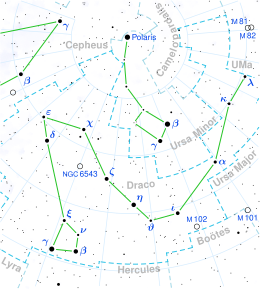Delta Draconis
| Observation data Epoch J2000 Equinox J2000 | |
|---|---|
| Constellation | Draco |
| Right ascension | 19h 12m 33.30137s[1] |
| Declination | +67° 39′ 41.5392″[1] |
| Apparent magnitude (V) | 3.07[2] |
| Characteristics | |
| Spectral type | G9 III[3] |
| U−B color index | +0.78[2] |
| B−V color index | +1.00[2] |
| Astrometry | |
| Radial velocity (Rv) | 24.71±0.16[4] km/s |
| Proper motion (μ) | RA: +94.599 mas/yr[1] Dec.: +92.374 mas/yr[1] |
| Parallax (π) | 33.3499 ± 0.1567 mas[1] |
| Distance | 97.8 ± 0.5 ly (30.0 ± 0.1 pc) |
| Absolute magnitude (MV) | +0.62[5] |
| Details[4] | |
| Mass | 1.70±0.18 M☉ |
| Radius | 10.52±0.24 R☉ |
| Luminosity | 59 L☉ |
| Surface gravity (log g) | 2.59±0.05 cgs |
| Temperature | 4,873±25 K |
| Metallicity [Fe/H] | −0.13±0.05 dex |
| Rotational velocity (v sin i) | 8[6] km/s |
| Age | 1.66±0.35 Gyr |
| Other designations | |
| Database references | |
| SIMBAD | data |
Delta Draconis (δ Draconis, abbreviated Delta Dra, δ Dra), formally named Altais /ælˈteɪ.ɪs/,[10] is a yellow star in the constellation of Draco. It has an apparent visual magnitude of 3.0,[2] making it easily visible to the naked eye. Based on parallax measurements obtained by the Gaia mission, it is approximately 97.8 light-years (30.0 parsecs) from the Sun.[1]
Nomenclature
[edit]δ Draconis (Latinised to Delta Draconis) is the star's Bayer designation.
It bore the traditional names Aldib, Altais[7] (the goat) and Nodus Secundus.[8] The title Altais was derived from Arabic Al Tāis "the Goat", the association of this star, along with Pi Draconis, Rho Draconis and Epsilon Draconis (Tyl).[11] According to a 1971 NASA catalog of stars, Al Tāis or Tais were the title for three stars : Delta Draconis as Altais, Pi Draconis as Tais I and Rho Draconis as Tais II (exclude Epsilon Draconis).[12] In 2016, the International Astronomical Union organized a Working Group on Star Names (WGSN)[13] to catalogue and standardize proper names for stars. The WGSN approved the name Altais for this star on 21 August 2016 and it is now so included in the List of IAU-approved Star Names.[10]
In Chinese, 天廚 (Tiān Chú, Tien Choo), meaning Celestial Kitchen or Heaven's Kitchen, refers to an asterism consisting of Delta Draconis, Sigma Draconis, Epsilon Draconis, Rho Draconis, 64 Draconis and Pi Draconis.[14] Consequently, the Chinese name for Delta Draconis itself is 天廚一 (Tiān Chú yī, English: the First Star of Celestial Kitchen).[15]
Properties
[edit]Delta Draconis is a giant star with a stellar classification of G9 III. This indicates that it has exhausted the supply of hydrogen at its core and entered a later stage in its evolution. Around 1.7 billion years old, Delta Draconis has expanded to 10.5 times the Sun's radius and is radiating 59 times the luminosity of the Sun from its outer atmosphere at an effective temperature of 4,873 K.[4] At this temperature, it is giving off the yellow-hued glow of a G-type star.[16] With a mass 1.7[4] times that of the Sun, this star will end its life as a white dwarf.[8]
Pole star
[edit]Delta Draconis is the northern pole star of Ceres, lying 1.5 degrees from the true pole.[17]
References
[edit]- ^ a b c d e Vallenari, A.; et al. (Gaia collaboration) (2023). "Gaia Data Release 3. Summary of the content and survey properties". Astronomy and Astrophysics. 674: A1. arXiv:2208.00211. Bibcode:2023A&A...674A...1G. doi:10.1051/0004-6361/202243940. S2CID 244398875. Gaia DR3 record for this source at VizieR.
- ^ a b c d Johnson, H. L.; Mitchell; Iriarte; Wisniewski (1966). "UBVRIJKL photometry of the bright stars". Communications of the Lunar and Planetary Laboratory. 4 (99): 99. Bibcode:1966CoLPL...4...99J.
- ^ Roman, Nancy G. (July 1952). "The Spectra of the Bright Stars of Types F5-K5". Astrophysical Journal. 116: 122. Bibcode:1952ApJ...116..122R. doi:10.1086/145598.
- ^ a b c d Jofré, E.; et al. (2015), "Stellar parameters and chemical abundances of 223 evolved stars with and without planets", Astronomy & Astrophysics, 574: A50, arXiv:1410.6422, Bibcode:2015A&A...574A..50J, doi:10.1051/0004-6361/201424474, S2CID 53666931, A50. Delta Draconis' database entry at VizieR.
- ^ Takeda, Yoichi; et al. (August 2008), "Stellar Parameters and Elemental Abundances of Late-G Giants", Publications of the Astronomical Society of Japan, 60 (4): 781–802, arXiv:0805.2434, Bibcode:2008PASJ...60..781T, doi:10.1093/pasj/60.4.781, S2CID 16258166
- ^ Bernacca, P. L.; Perinotto, M. (1970). "A catalogue of stellar rotational velocities". Contributi Osservatorio Astronomico di Padova in Asiago. 239 (1): 1. Bibcode:1970CoAsi.239....1B.
- ^ a b Bakich, Michael E. (1995). The Cambridge guide to the constellations. Cambridge University Press. p. 184. ISBN 0-521-44921-9.
- ^ a b c Kaler, James B. "Nodus Secundus". STARS. University of Illinois. Retrieved 2010-04-06.
- ^ "del Dra -- Star in double system". SIMBAD. Centre de Données astronomiques de Strasbourg. Retrieved 2010-04-06.
- ^ a b "Naming Stars". IAU.org. Retrieved 4 March 2018.
- ^ Allen, R. H. (1963). Star Names: Their Lore and Meaning (Reprint ed.). New York, NY: Dover Publications Inc. p. 209. ISBN 0-486-21079-0. Retrieved 2010-12-12.
- ^ Rhoads, Jack W. (November 15, 1971). "Technical Memorandum 33-507-A Reduced Star Catalog Containing 537 Named Stars" (PDF). Jet Propulsion Laboratory, California Institute of Technology.
- ^ IAU Working Group on Star Names (WGSN), International Astronomical Union, retrieved 22 May 2016.
- ^ (in Chinese) 中國星座神話, written by 陳久金. Published by 台灣書房出版有限公司, 2005, ISBN 978-986-7332-25-7.
- ^ (in Chinese) 香港太空館 - 研究資源 - 亮星中英對照表 Archived October 25, 2008, at the Wayback Machine, Hong Kong Space Museum. Accessed on line November 23, 2010.
- ^ "The Colour of Stars", Australia Telescope, Outreach and Education, Commonwealth Scientific and Industrial Research Organisation, December 21, 2004, archived from the original on March 18, 2012, retrieved 2012-01-16
- ^ "Dawn explores Ceres: Results from the survey orbit" (PDF). Archived from the original (PDF) on 2015-09-05. Retrieved 2017-03-30.

